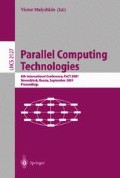Abstract
Percolation is the process that causes a a solvent (e.g. water) to pass through a permeable substance and to extract a soluble constituent. Cellular Automata provide a very powerful tool for the simulation and the analysis of percolation processes. In some cases, however, the most challenging problem is perhaps to reproduce correctly within the automaton the features of the percolation bed, that is, the porous medium the solvent flows through. In this paper we present a computational model for the controlled generation of two-dimensional percolation beds based on stochastic Cellular Automata, and we show how it has been applied to the generation of percolation beds suitable for the simulation of pesticide percolation in the soil. In particular, the approach we present permits to keep under control the shape and the size of the single components of the bed (e.g. grains), and their position. In order to reproduce percolation beds of feasible size, and to manage large automata, the model has been implemented on a cluster of workstations.
Access this chapter
Tax calculation will be finalised at checkout
Purchases are for personal use only
Preview
Unable to display preview. Download preview PDF.
References
D. Stauffer, A. Aharony. Introduction to Percolation Theory. Taylor & Francis, London, 1992.
M. Sahimi. Applications of Percolation Theory. Taylor & Francis, London, 1994.
M. Sahimi (ed.). Flow Phenomena in Rocks: from Continuum Models to Fractals, Percolation, Cellular Automata and Simulated Annealing. Rev. of Modern Physics, 65(4), 1993.
C. Borsani, G. Cattaneo, V. de Mattei, U. Jocher, B. Zampini. 2D and 3D Lattice Gas Techniques of Fluid-Dynamic Simulations. In S. Bandini, R. Serra, F. Suggi Liverani (eds.), Cellular Automata: Research Towards Industry, Springer Verlag, Berlin, 1998.
S. Bandini, G. Mauri, G. Pavesi, C. Simone. A Parallel Model Based on Cellular Automata for the Simulation of Pesticide Percolation in the Soil. In V Malyshkin (ed.), Parallel Computing and Technologies, Lecture Notes in Computer Science 1662, Springer Verlag, Berlin, 1999.
S. Bandini, M. Magagnini. Parallel Simulation of Dynamic Properties of Filled Rubber Compounds Based on Cellular Automata. Parallel Computing, 27(5), 643–661, 2001.
S. Bandini, G. Mauri, G. Pavesi, C. Simone. Parallel Simulation of Reaction Diffusion Phenomena in Percolation Processes: a Model Based on Cellular Automata. Future Generation Computer Systems, 17(6), 679–688, 2001.
Author information
Authors and Affiliations
Editor information
Editors and Affiliations
Rights and permissions
Copyright information
© 2001 Springer-Verlag Berlin Heidelberg
About this paper
Cite this paper
Bandini, S., Mauri, G., Pavesi, G. (2001). Parallel Generation of Percolation Beds Based on Stochastic Cellular Automata. In: Malyshkin, V. (eds) Parallel Computing Technologies. PaCT 2001. Lecture Notes in Computer Science, vol 2127. Springer, Berlin, Heidelberg. https://doi.org/10.1007/3-540-44743-1_40
Download citation
DOI: https://doi.org/10.1007/3-540-44743-1_40
Published:
Publisher Name: Springer, Berlin, Heidelberg
Print ISBN: 978-3-540-42522-9
Online ISBN: 978-3-540-44743-6
eBook Packages: Springer Book Archive

